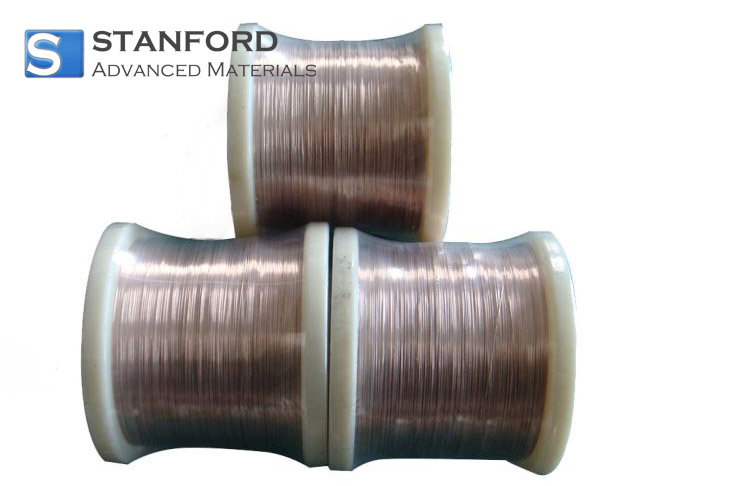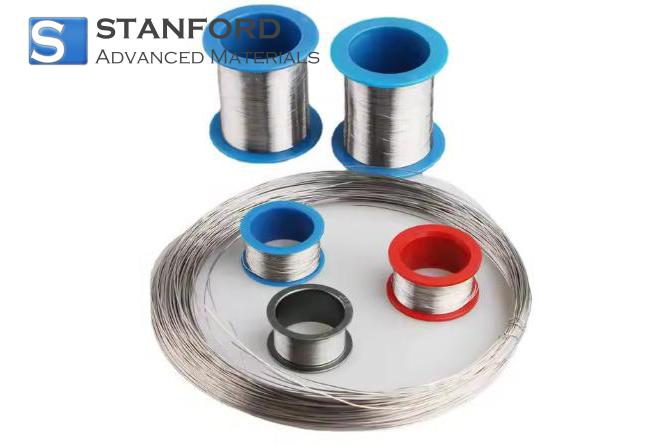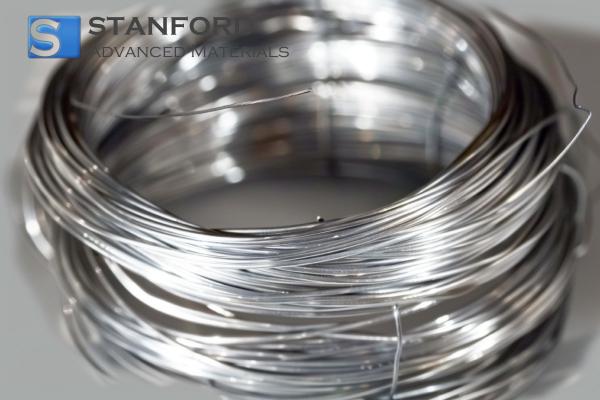SECTION 1. IDENTIFICATION
Product Name: Platinum Rhodium Wire
CAS #: 11107-71-4
Relevant identified uses of the substance: Scientific research and development
Supplier details:
Stanford Advanced Materials
E-mail: sales@samaterials.com
Tel: (949) 407-8904
Address: 23661 Birtcher Dr., Lake Forest, CA 92630 U.S.A.
SECTION 2. HAZARDS IDENTIFICATION
2.1 Classification of the substance or mixture
Not a hazardous substance or mixture.
2.2 GHS Label elements, including precautionary statements
Not a hazardous substance or mixture.
2.3 Hazards not otherwise classified (HNOC) or not covered by GHS - none
SECTION 3. COMPOSITION/INFORMATION ON INGREDIENTS
3.1 Substances
Chemical characterization : Product does not burn
Synonyms : Pt16Rh13
Formula : PtRh
Molecular Weight : 297.98 g/mol
CAS-No. : 11107-71-4
No ingredients are hazardous according to OSHA criteria.
No components need to be disclosed according to the applicable regulations.
SECTION 4. FIRST AID MEASURES
4.1 Description of first aid measures
If inhaled
If breathed in, move person into fresh air. If not breathing, give artificial respiration.
In case of skin contact
Wash off with soap and plenty of water.
In case of eye contact
Flush eyes with water as a precaution.
If swallowed
Never give anything by mouth to an unconscious person. Rinse mouth with water.
4.2 Most important symptoms and effects, both acute and delayed
The most important known symptoms and effects are described in the labelling (see section 2.2)
and/or in section 11
4.3 Indication of any immediate medical attention and special treatment needed
no data available
SECTION 5. FIREFIGHTING MEASURES
5.1 Extinguishing media
Suitable extinguishing media
Use extinguishing measures that are appropriate to local circumstances and the surrounding
environment.
5.2 Special hazards arising from the substance or mixture
Rhodium/rhodium oxides
5.3 Advice for firefighters
Wear self contained breathing apparatus for fire fighting if necessary.
5.4 Further information
The product itself does not burn.
SECTION 6. ACCIDENTAL RELEASE MEASURES
6.1 Personal precautions, protective equipment and emergency procedures
Avoid dust formation. Avoid breathing Vapors, mist or gas.
For personal protection see section 8.
6.2 Environmental precautions
Do not let product enter drains.
6.3 Methods and materials for containment and cleaning up
Sweep up and shovel. Keep in suitable, closed containers for disposal.
6.4 Reference to other sections
For disposal see section 13.
SECTION 7. HANDLING AND STORAGE
7.1 Precautions for safe handling
Provide appropriate exhaust ventilation at places where dust is formed.
For precautions see section 2.2.
7.2 Conditions for safe storage, including any incompatibilitiesKeep container tightly closed in a dry and well-ventilated place.
7.3 Specific end use(s)
Apart from the uses mentioned in section 1.2 no other specific uses are stipulated
SECTION 8. EXPOSURE CONTROLS/PERSONAL PROTECTION
8.1 Control parameters
Components with workplace control parameters
Contains no substances with occupational exposure limit values.
8.2 Exposure controls
Appropriate engineering controls
General industrial hygiene practice.
Personal protective equipment
Eye/face protection
Use equipment for eye protection tested and approved under appropriate government standards such
as
NIOSH (US) or EN 166(EU).
Skin protection
Handle with gloves. Gloves must be inspected prior to use. Use proper glove removal technique
(without
touching glove's outer surface) to avoid skin contact with this product. Dispose of contaminated gloves
after
use in accordance with applicable laws and good laboratory practices. Wash and dry hands.
Body Protection
Choose body protection in relation to its type, to the concentration and amount of dangerous
substances, and
to the specific work-place., The type of protective equipment must be selected according to the
concentration
and amount of the dangerous substance at the specific workplace.
Respiratory protection
Respiratory protection is not required. Where protection from nuisance levels of dusts are desired, use
type
N95 (US) or type P1 (EN 143) dust masks. Use respirators and components tested and approved
under
appropriate government standards such as NIOSH (US) or CEN (EU).
Control of environmental exposure
Do not let product enter drains.
SECTION 9. PHYSICAL AND CHEMICAL PROPERTIES
9.1 Information on basic physical and chemical properties
a) Appearance Form: Wire
b) Odor no data available
c) Odor Threshold no data available
d) pH no data available
e) Melting point/freezing
point
no data available
f) Initial boiling point and
boiling range
no data availableg) Flash point not applicable
h) EVaporation rate no data available
i) Flammability (solid, gas) no data available
j) Upper/lower
flammability or
explosive limits
no data available
k) Vapor pressure no data available
l) Vapor density no data available
m) Relative density no data available
n) Water solubility no data available
o) Partition coefficient: noctanol/
water
no data available
p) Auto-ignition
temperature
no data available
q) Decomposition
temperature
no data available
r) Viscosity no data available
s) Explosive properties no data available
t) Oxidizing properties no data available
9.2 Other safety information
no data available
SECTION 10. STABILITY AND REACTIVITY
10.1 Reactivity
no data available
10.2 Chemical stability
Stable under recommended storage conditions.
10.3 Possibility of hazardous reactions
no data available
10.4 Conditions to avoid
no data available
10.5 Incompatible materials
Strong oxidizing agents
10.6 Hazardous decomposition products
Other decomposition products - no data available
In the event of fire: see section 5
SECTION 11. TOXICOLOGICAL INFORMATION
11.1 Information on toxicological effects
Acute toxicity
no data available
Inhalation: no data available
Dermal: no data available
no data available
Skin corrosion/irritationno data available
Serious eye damage/eye irritation
no data available
Respiratory or skin sensitisation
no data available
Germ cell mutagenicity
no data available
Carcinogenicity
IARC: No component of this product present at levels greater than or equal to 0.1% is identified as
probable, possible or confirmed human carcinogen by IARC.
ACGIH: No component of this product present at levels greater than or equal to 0.1% is identified as a
carcinogen or potential carcinogen by ACGIH.
NTP: No component of this product present at levels greater than or equal to 0.1% is identified as a
known or anticipated carcinogen by NTP.
OSHA: No component of this product present at levels greater than or equal to 0.1% is identified as a
carcinogen or potential carcinogen by OSHA.
Reproductive toxicity
no data available
no data available
Specific target organ toxicity - single exposure
no data available
Specific target organ toxicity - repeated exposure
no data available
Aspiration hazard
no data available
Additional Information
RTECS: Not available
SECTION 12. ECOLOGICAL INFORMATION
12.1 Toxicity
no data available
12.2 Persistence and degradability
no data available
12.3 Bioaccumulative potential
no data available
12.4 Mobility in soil
no data available
12.5 Results of PBT and vPvB assessment
PBT/vPvB assessment not available as chemical safety assessment not required/not conducted
12.6 Other adverse effects
no data available
SECTION 13. DISPOSAL CONSIDERATIONS
13.1 Waste treatment methods
Product
Offer surplus and non-recyclable solutions to a licensed disposal company.
Contaminated packaging
Dispose of as unused product.
SECTION 14. TRANSPORT INFORMATION
DOT (US)
Not dangerous goods
IMDG
Not dangerous goods
IATA
Not dangerous goods
SECTION 15. REGULATORY INFORMATION
SARA 302 Components
SARA 302: No chemicals in this material are subject to the reporting requirements of SARA Title III,
Section 302.
SARA 313 Components
SARA 313: This material does not contain any chemical components with known CAS numbers that
exceed the
threshold (De Minimis) reporting levels established by SARA Title III, Section 313.
SARA 311/312 Hazards
No SARA Hazards
Massachusetts Right To Know Components
No components are subject to the Massachusetts Right to Know Act.
Pennsylvania Right To Know Components
Platinum/rhodium alloy
CAS-No.
11107-71-4
Revision Date
New Jersey Right To Know Components
Platinum/rhodium alloy
CAS-No.
11107-71-4
Revision Date
California Prop. 65 Components
This product does not contain any chemicals known to State of California to cause cancer, birth
defects, or any other
reproductive harm.
SECTION 16. OTHER INFORMATION
Safety Data Sheet according to Regulation (EC) No. 1907/2006 (REACH). The above information is
believed to be correct but does not purport to be all inclusive and shall be used only as a guide. The
information in this document is based on the present state of our knowledge and is applicable to the
product with regard to appropriate safety precautions. It does not represent any guarantee of the
properties of the product.


 English
English Española
Española Deutsch
Deutsch Français
Français Italiano
Italiano








